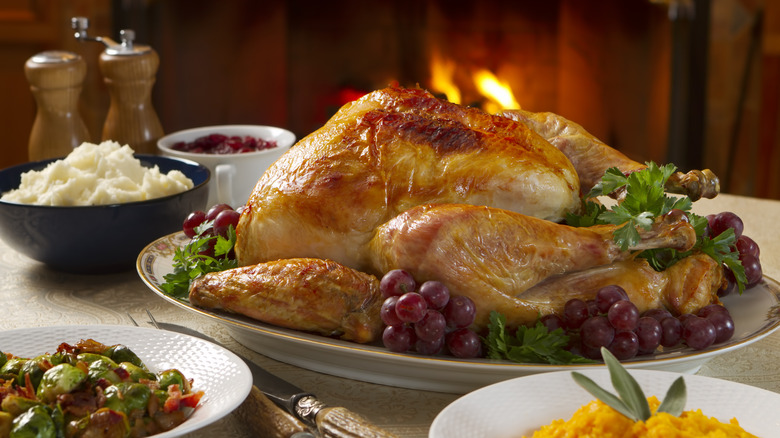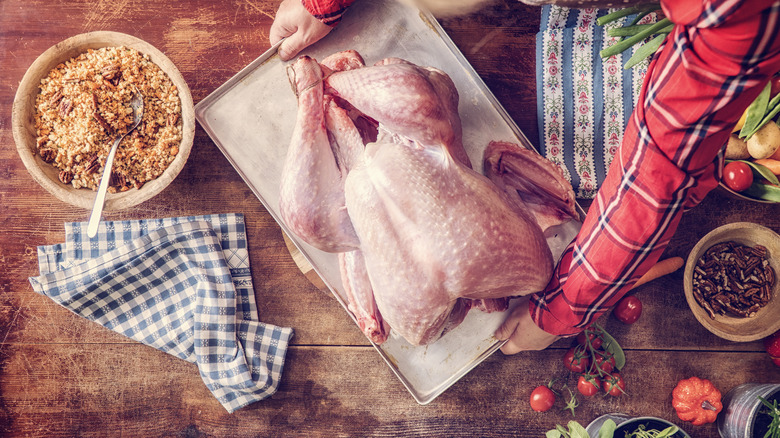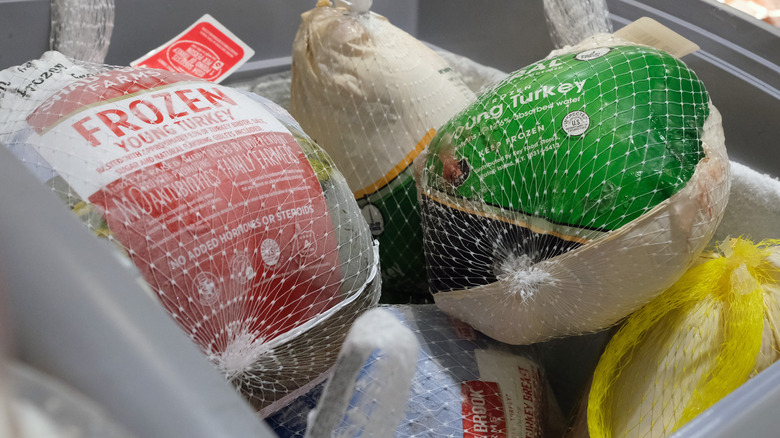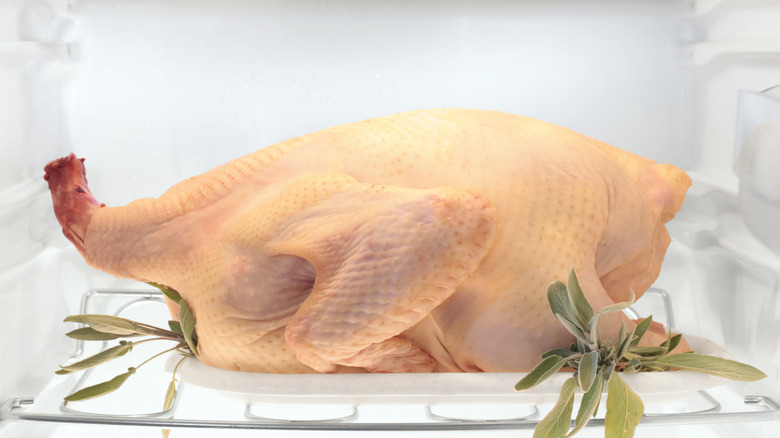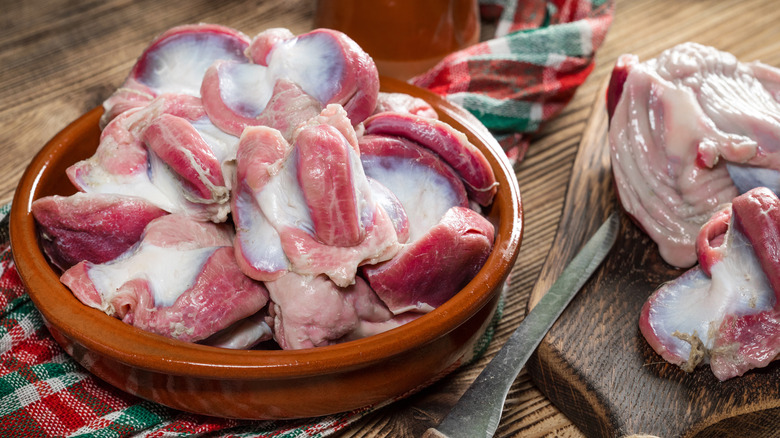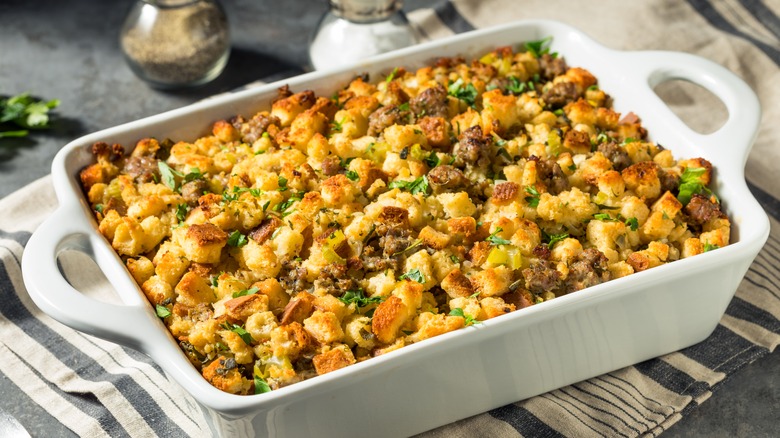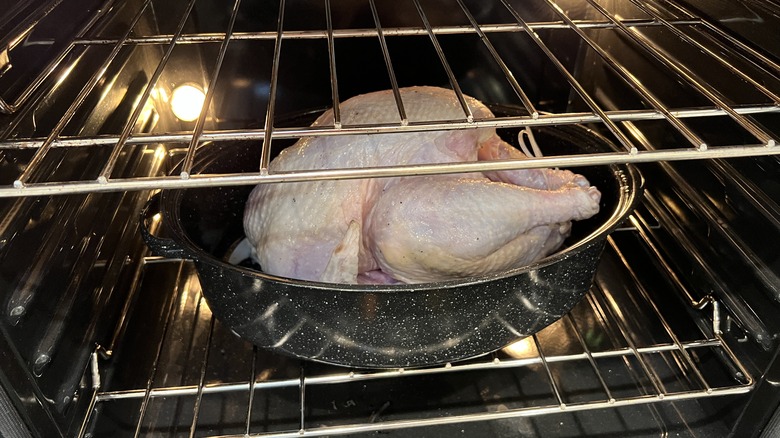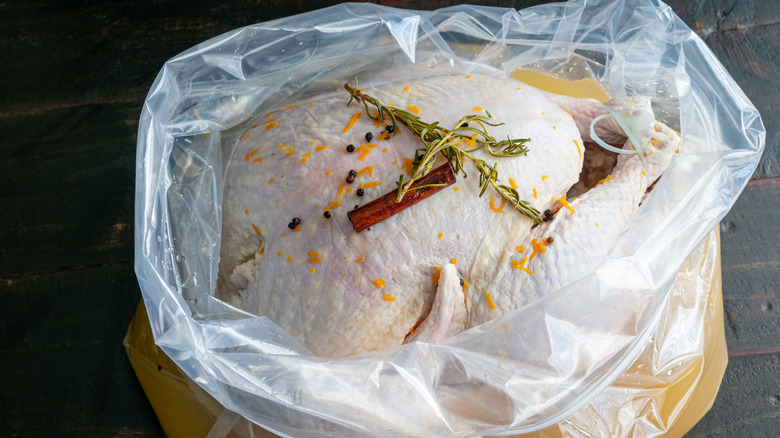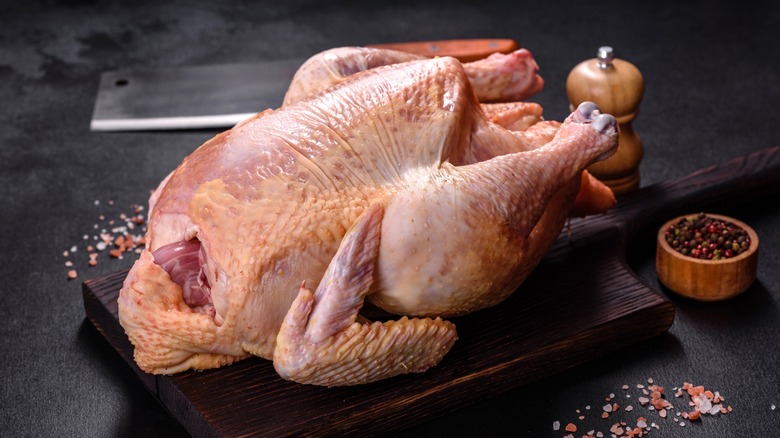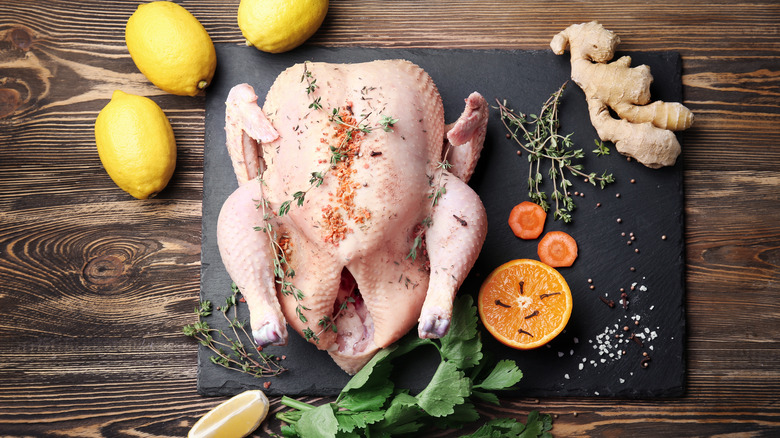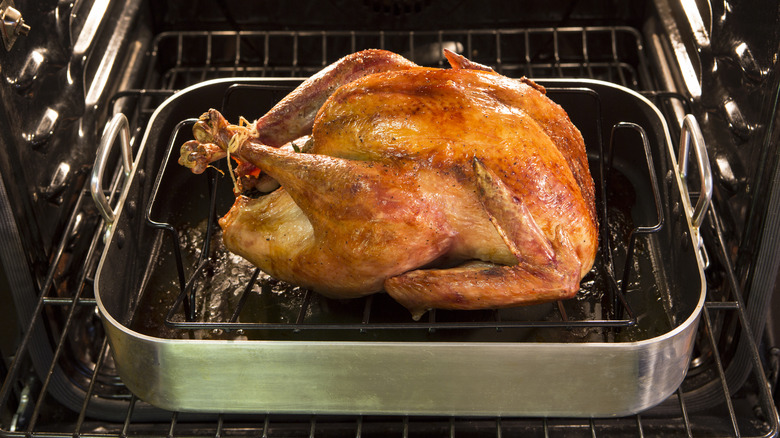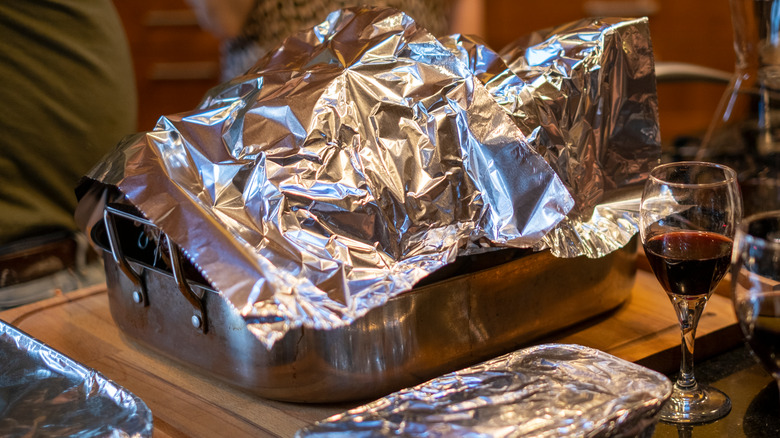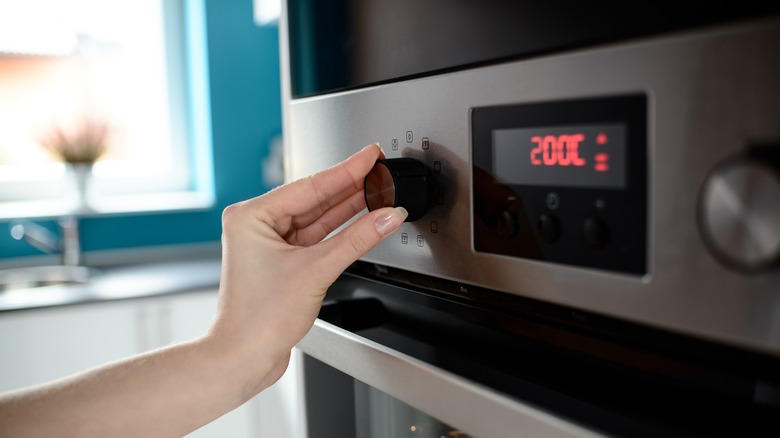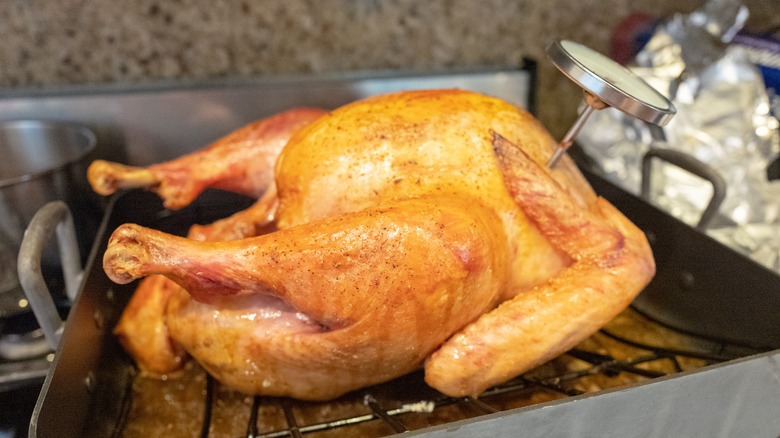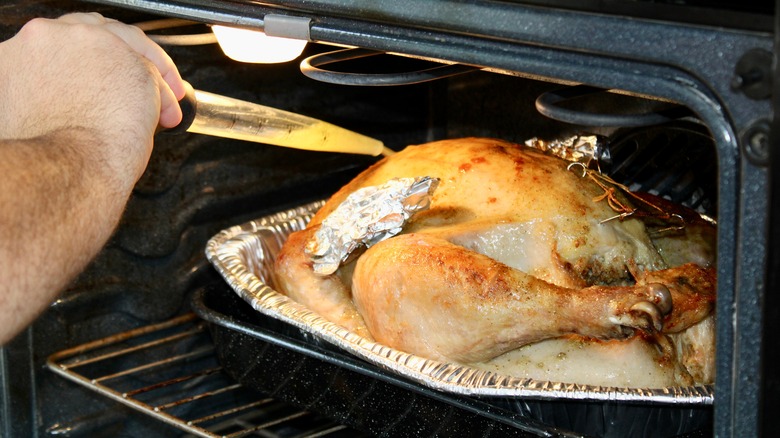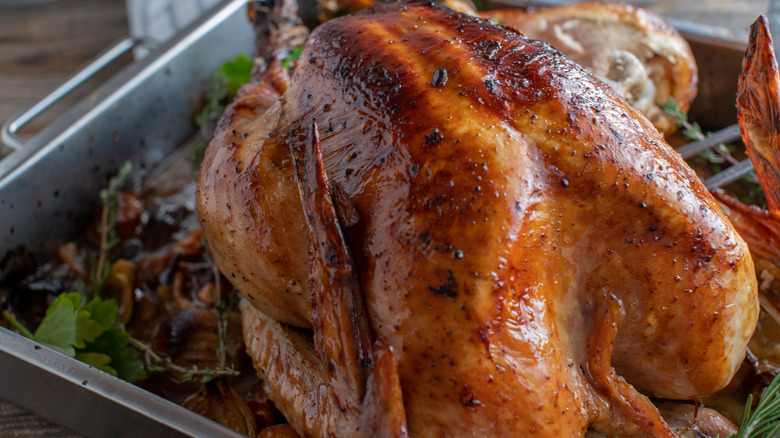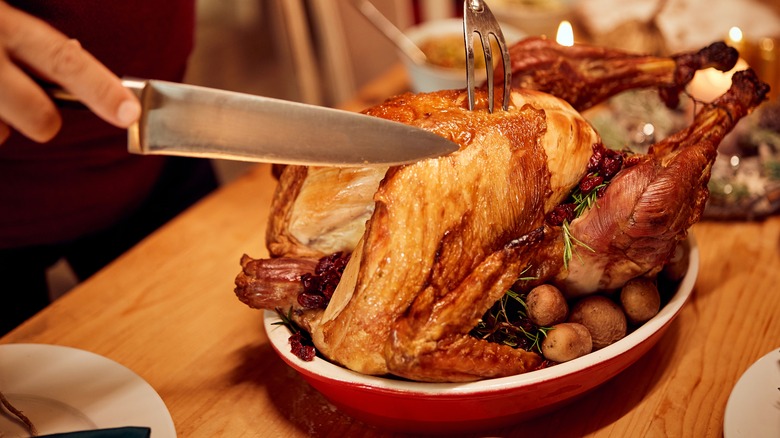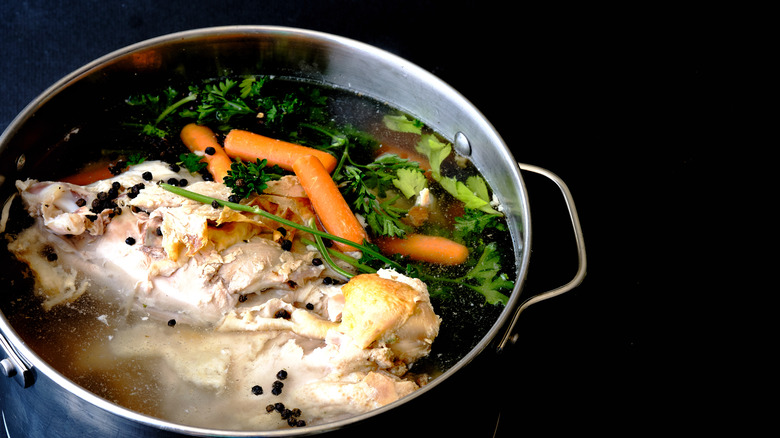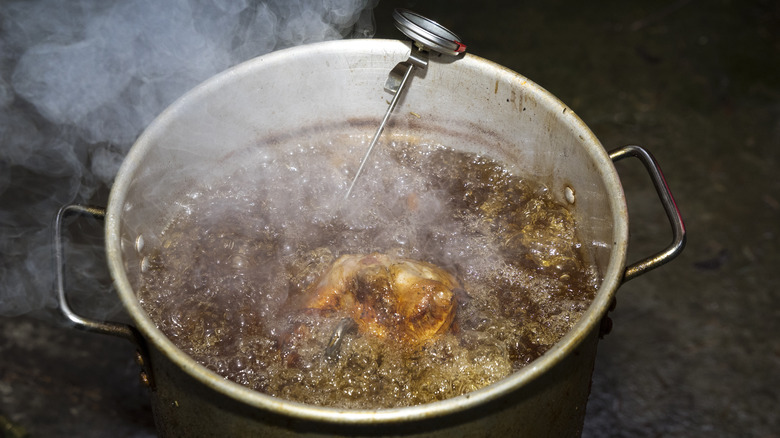18 Mistakes Everyone Makes When Cooking Thanksgiving Turkey And How To Avoid Them
Thanksgiving is one of the best holidays of the year. Aside from the opportunity to spend time with loved ones and show gratitude for the things in our lives that bring us joy, it is a celebration focused on cooking and eating a delectable meal. The central symbol of this iconic celebration is the perfect, golden brown, moist turkey.
Roasting a whole turkey can be an intimidating process, especially if it is the first time you are doing it. While it seems like it should be pretty straightforward, the truth is, there are a lot of things that can go wrong from the moment you decide on which turkey to purchase to the bird making it onto your guest's dinner plates.
Fear not. I have anticipated every possible pitfall you might encounter on your turkey-making journey based on my personal experiences, both positive and negative, as a chef preparing countless turkeys over the years in my restaurant and at home. Let me guide you every step of the way on what not to do when preparing your Thanksgiving turkey. I will teach you how to make the most luscious bird imaginable that will impress even the most discerning foodie on your guest list.
1. Purchasing the wrong size turkey
Buying a turkey that is too large is less of an issue than the reverse because one of the best parts about Thanksgiving is having leftovers. Not having enough turkey is a whole different ball game. There is nothing worse than running out of the main entree' halfway through the meal.
A great rule of thumb is to aim for about 1-½ pounds of turkey per person. This may seem like a lot, but a large percentage of the weight is the carcass. For example, if you expect 10 people on Thanksgiving, you will need a 15-pound turkey.
And if you know more people prefer light to dark meat, consider opting for boneless turkey breasts rather than a whole bird. If you go this route, you will want to factor in about 1 pound per person, which means you will need about 10 pounds of turkey breast to feed 10 people.
2. Buying a poor quality turkey
In terms of quality, fresh and frozen turkeys are identical. A bird marked as "fresh" is never cooled below 26 degrees Fahrenheit. Those that are frozen are chilled to 0 degrees Fahrenheit or colder immediately upon being packaged.
Another consideration may include a turkey that is "self-basting" or "basted," which indicates the bird was injected with a combination of ingredients designed to moisten the meat and give its skin a browner, crisper texture. The ingredients included in this solution must be clearly labeled for allergens and cannot make up more than 3% of the mass of the bird, but you are paying for some of that weight.
If you plan to order a heritage breed of turkey directly from the farm, these birds tend to have less light versus dark meat than store-bought turkey. While they can have a more complex flavor, they take some finesse when roasting to ensure the breast meat remains moist.
3. Forgetting to allow plenty of time to thaw your turkey
It is best to thaw a turkey in the refrigerator. This should take one day per 4 pounds of turkey or roughly four days for a 15-pound turkey. If you forget to thaw it in advance, you can use the cold water thawing method in a pinch.
This method involves submerging your wrapped turkey breast side down in cold water. Set a timer and replace the cold water completely every 30 minutes. If you cannot keep the bird fully submerged, you will need to rotate the turkey each time you substitute the water. This method will take 30 minutes per pound to thaw. A 15-pound turkey will take about 7-½ hours to thaw.
The best rule of thumb is to thaw your bird well in advance. A fully thawed bird can safely remain in the refrigerator for four days.
4. Forgetting to remove the giblet package from the turkey
According to the USDA, all may not be lost if you forget to remove the package of giblets from the cavity of your turkey before roasting it. Giblets wrapped in paper cooked to a safe temperature can be used or discarded. Giblets packaged in plastic are safe to consume as long as the packaging has not been compromised in any capacity. Melted plastic can cause dangerous chemicals to seep into your turkey, contaminating the giblets and surrounding meat.
If you are wondering what to do with those giblets once cooked, they can be delicious when added to your dressing or chopped into your homemade gravy. My favorite way to use them comes from my Eastern European heritage. We would sauté the chopped or ground giblets with aromatics and brandy and turn them into a rich paté. This is served as an appetizer with toast points.
5. Stuffing your turkey
Stuffing your turkey sounds like a great idea. It looks beautiful inside the bird when presented, and the juices from the turkey will baste the stuffing with flavor. Unfortunately, the USDA recommends against this practice. For stuffing to be safely cooked, it must reach a temperature of 165 degrees Fahrenheit. To accomplish this, the likelihood of over-roasting your bird and ending up with a dry turkey is high.
Stuffing a bird can have another unintended consequence. It can act like a sponge, soaking up moisture that would better be left inside the bird, helping to keep your turkey juicy.
We recommend baking your stuffing mixture separately. To impart some of that delicious turkey flavor, consider roasting the giblets ahead of time and incorporating them into your stuffing. And if you wondered what the difference is between stuffing and dressing, once you bake it outside of the bird, it is called dressing.
6. Putting a cold turkey in the oven
As tempting as it may seem, you should never roast a partially frozen turkey. It is virtually impossible to ensure it will cook thoroughly. Some parts will end up overcooked, while others may not reach the safe internal temperature of 165 degrees Fahrenheit.
This advice extends to a cold turkey. You never want to put refrigerated meat straight into a hot pan or oven. Doing so will cause the meat to seize up and shrink. It will also dry it out by forcing moisture to the surface rather than sealing those juices inside the meat. Finally, it causes the meat to roast unevenly, which may mean parts of the bird will be overdone while others will be underdone.
For optimal results, remove your turkey from the refrigerator about one hour before placing it in the oven. This will give your bird the best flavor and texture and maximize yield. And don't forget to preheat your oven.
7. Over brining a turkey
Wet brining a turkey can infuse it with flavor and tenderize the bird by breaking down the proteins in dense muscle fibers, rendering the meat more supple. But, there are some pitfalls to avoid with brining. The USDA recommends never washing a turkey before doing so as this can encourage cross-contamination. Second, never brine the turkey for longer than two days. Finally, keep the turkey in its brine inside the refrigerator.
To prevent the bird from being overly salty, use a fresh or frozen one that has not been injected with a sodium solution. When you brine a frozen bird, it may be beneficial to reduce the amount of salt you add to the brine and to shorten the amount of time the bird spends in the liquid. Once you have finished brining the turkey, you will want to rinse it well and soak it in cold water for 15 minutes to remove any excess salinity.
8. Not patting your turkey dry all over
If you have ever wondered why the skin on your turkey did not brown and get crispy in the oven, there was likely too much residual moisture on the skin. Excess moisture will steam rather than sear your turkey, giving it a squishy texture that is unappealing. This is particularly problematic if you have wet-brined your bird, as it will retain even more excess moisture.
The solution is to dry your bird thoroughly with paper towels. And don't forget to dry the inside as well. Residual moisture from the cavity will leach, making your bird wet again. For extra measure, it is recommended that you place your dried bird onto a baking rack uncovered in the refrigerator overnight. The cold air of the refrigerator will help to wick any remaining moisture away from the turkey, ensuring crunchy, delicious skin.
9. Only seasoning the exterior of your turkey
If you are not planning on wet brining your turkey, you might consider a dry brine. This process involves rubbing your dried bird inside and out with a seasoned salt mixture and allowing the bird to sit uncovered in the refrigerator for an hour per pound. Never rinse the seasoning from the turkey; those flavors will permeate the skin, dissolving excess salt and leaving more tender meat.
Once you have dry-brined your turkey, you will want to infuse it with even more flavor. This can be accomplished in several ways, including injecting it with a marinade or glazing the exterior. My preferred method of adding flavor is to coat the bird above and below the skin with a compound butter loaded with fresh herbs and citrus zest. I also stuff the cavity with aromatics like onions, garlic, and halved citrus fruit. If you want to skip the compound butter, mayonnaise works well to impart flavor and brown the skin.
10. Not using a roasting rack
Roasting pans with racks are the ideal cooking vessels for the perfect turkey. First, they are designed to withstand longer cooking times at high temperatures without shattering. Second, the roasting rack enables adequate airflow to circulate all around the turkey, which will not only promote more even cooking but will help make the skin surrounding the entire bird crispy. Finally, they have high-rimmed edges, which will help trap turkey juices and keep them from turning your oven into a mess.
If you do not have a rack for your roasting pan, there are substitutes. A metal cooling rack can work quite well, as can a makeshift rack made from wadded-up balls of aluminum foil. If all else fails, try coating the bottom of your pan with vegetables. They will prop your turkey up and will also release moisture as they cook, which can steam the bottom of your turkey.
11. Not covering your turkey while it roasts
The age-old issue with roasting a whole turkey is that the breast tends to dry out before the thigh meat is fully cooked to 165 degrees Fahrenheit. Some recipes recommend starting your turkey breast side down and then flipping it midway through the roasting process to encourage self-basting. This makes zero sense from a logistical perspective. It is practically impossible to handle a 15-pound hot turkey safely enough to rotate it without it slipping out of your hands and turning the whole kitchen into a slimy mess.
The best way to prevent the breast meat from drying out is to cover it loosely in aluminum foil. Do not encase the entire turkey, just the breast meat. You will want to remove the foil about 30 minutes to an hour before the turkey is done to ensure the skin surrounding the breast meat has plenty of time to get crispy and golden brown.
12. Roasting your turkey at the wrong temperature
Advice for the ideal temperature to roast a turkey is as varied as human fingerprints. Some swear by beginning the bird at a higher temperature to brown the skin, then covering it in foil and lowering the temperature to finish off the bird. The danger of this method is that you can easily overcook your turkey, drying it out. Alternatively, you can end up with burnt skin and a turkey that is undercooked inside.
In my experience, low, slow, and steady wins the race. The ideal temperature is 325 degrees Fahrenheit. You will want to factor in about 13 minutes per pound in terms of cooking time, depending on your oven. This means a 15-pound turkey should take approximately 3-½ hours to roast. And while convection ovens are great for circulating air, I do not recommend them for roasting a turkey. They tend to burn the exterior before the interior is cooked.
13. Not using a thermometer
Cooking your turkey to 165 degrees Fahrenheit is critical for ensuring the bird is safe to consume. The only way to securely determine the doneness of your turkey is to use a meat thermometer. While you can purchase birds with a built-in pop-up thermometer designed to spring when it reaches 165 degrees, these can often fail. It is recommended that you use either an oven-safe or digital thermometer to test your turkey regularly.
An oven-safe thermometer should be inserted into the thickest part of the thigh of the turkey before placing it into the oven. When using a digital thermometer, begin testing the internal temperature at the low end of when the turkey might potentially be done. For a 15-pound turkey, this would be around the 3-hour mark. You should take two measurements. One with the thermometer inserted into the fleshiest part of the breast and the other into the center of the thigh but not touching the bone.
14. Basting your turkey
Turkey basters have a lot of uses. One thing they should never be used for is basting your turkey. This may sound counterintuitive based on everything we have always been told. The truth is that basting does little to moisten your turkey. All you are accomplishing by opening and closing your oven door is allowing the heat from your oven to escape, which will prolong the roasting time for your turkey, making it more likely to dry out in the long run.
If you are concerned about your turkey staying moist, don't forget to brine it and coat it with either compound butter or mayonnaise. I have also conferred extra moisture into the breast by topping it with strips of bacon, which I remove toward the end of cooking to crisp up the skin. The bottom line is that the best thing you can do to keep your turkey moist is avoid overcooking it.
15. Not allowing your turkey to rest before carving it
Another critical factor in keeping your turkey moist is to avoid carving it immediately after removing it from the oven. Allow your turkey to rest for at least 30 minutes before carving for a smaller bird. Turkeys over 15 pounds can sit for up to 45 minutes.
The resting process does two things. First, it allows the bird to cook five to 10 degrees more, ensuring the dark meat is thoroughly done. It also enables the juices within the turkey to redistribute and get reabsorbed within the bird, keeping the meat moist. Though some suggest not covering your turkey with foil while resting it, in my experience, this helps to retain more moisture even if it sacrifices a hint of crispiness in the skin.
Whatever you do, never let your cooked turkey remain at room temperature for longer than two hours. That is when pathogens can begin to form, rendering your turkey potentially hazardous to consume.
16. Carving your turkey incorrectly
The single most important advice when carving a turkey is to use a very sharp knife. You will also want to ensure your cutting board is stabilized with moist paper towels. Finally, keep some paper towels on hand to help you grasp the turkey while you carve it.
Begin by removing the legs and thighs. This can be accomplished by cutting through the meat near the thigh until you hit the joint. Snap the joint, and you should be able to cut through it. Next, you will want to pop off the wings by cutting through the joint with your knife. Finally, slice the breast meat along the backbone and away from the carcass. Once the entire breast is removed, it can easily be segmented.
If you'd like to separate the thigh from the drumstick, insert your knife between the joint until the two pieces can be pulled apart. Your turkey is now ready to be plated.
17. Discarding the leftovers
If you aren't saving your turkey carcass, the drippings in the roasting pan, and your leftover turkey, you are wasting a lot of culinary potential. The best homemade gravy is made by scraping up the drippings at the bottom of the roasting pan, making a roux with it, and finishing this with stock.
The turkey carcass can easily be turned into homemade stock. Transfer the bones, skin, and remaining meat into a stock pot. Add chunks of carrots, onions, and celery, and cover the whole thing with water. Bring this to a boil and skim off any scum that rises to the surface. Cover and reduce heat to a simmer. Allow your stock to simmer for about four hours before draining.
There are plenty of ways to use up those turkey leftovers. Favorites include casseroles, stews, salads, and frittatas. Whatever you do not use up within three to four days can be double-wrapped and placed in an airtight container to be frozen for up to six months.
18. Not considering alternative cooking methods
Roasting a turkey is the classic way to prepare it for your Thanksgiving feast. That said, if you are running low on oven real estate or want to try something new, you should consider alternative cooking methods. Smoking or grilling a turkey can impart a distinct flavor, keep your bird moist, and is ideal for birds too large to fit into your oven.
Frying a turkey is the fastest method for cooking a perfectly moist turkey. The key is to do so safely. Never fry a turkey indoors, not even in your garage. Make sure your turkey is thoroughly thawed so that it doesn't cause the oil to spatter. Do not overfill your fryer with oil, and make sure you cook your turkey to 165 degrees Fahrenheit before allowing it to rest. Finally, make sure you dispose of the oil safely. Check with your local waste management for any special disposal instructions, and never pour the grease down the drain of your kitchen sink.
